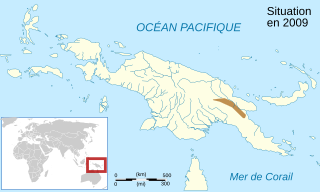Choerophryne exclamitans is a species of frogs in the family Microhylidae. It is endemic to the Morobe Province of mainland Papua New Guinea and known from two locations on the slopes of Mount Shungol, its type locality, and from the Huon Peninsula.
Choerophryne sanguinopicta is a species of frogs in the family Microhylidae. It is endemic to southeastern Papua New Guinea and only known from the vicinity of its type locality, the northern slope of Mt. Simpson in the Owen Stanley Range, Milne Bay Province, although it is expected to occur more widely. The specific name sanguinopictus, from Latin for sanguis ("blood") and pictus ("painted") refers to the distinctive red blotching and punctations characteristic for this species.
Austrochaperina basipalmata is a species of frog in the family Microhylidae. It is endemic to the mountain ranges of northern New Guinea and is found between Tawarin River in Papua, Western New Guinea (Indonesia) and Torricelli Mountains in Papua New Guinea.
Austrochaperina blumi is a species of frog in the family Microhylidae. It is endemic to New Guinea and known from the northern slopes of the New Guinean Central Range in Western New Guinea (Indonesia), and from the Bewani, Torricelli, and Hunstein Mountains in Papua New Guinea. The specific name blumi honors J. Paul Blum, the herpetologist who collected the type series. Common name Kosarek land frog has been proposed for it.
Austrochaperina brevipes is a species of frog in the family Microhylidae. It is endemic to Papua New Guinea and known only from two localities, Mount Victoria and Myola Guest House in the Owen Stanley Range. Common name Victoria land frog has been suggested for it.
Choerophryne allisoni is a tiny species of frog in the family Microhylidae. It is endemic to Papua New Guinea and only known from its type locality, Mount Sisa in the Southern Highlands Province. The specific name allisoni honours Allen Allison, an American herpetologist. Common name Allison's mountain frog has been coined for this species.

Cophixalus parkeri is a species of frog in the family Microhylidae. It is endemic to Papua New Guinea where it occurs in the central mountainous region between Chimbu and Morobe Provinces. The specific name parkeri presumably honours Hampton Wildman Parker, an English zoologist and herpetologist to whose perusal Arthur Loveridge sent the holotype. Common name Papua rainforest frog has been coined for it.

Cophixalus pipilans is a species of frog in the family Microhylidae. It is endemic to northern mainland Papua New Guinea and occurs between Lae and the Adelbert Mountains. The specific name pipilans is derived from the Latin verb pipilio and means "peeping". Common name Sempi rainforest frog has been coined for this species.
Sphenophryne coggeri is a species of frog in the family Microhylidae. It is endemic to New Guinea and known from two regions in Papua New Guinea, one in the Madang Province and the other in the Southern Highlands Province. The specific name coggeri honors Harold Cogger, a herpetologist from the Australian Museum.

Sphenophryne cornuta is a species of frogs in the family Microhylidae. It is endemic to New Guinea where it is widespread and found both in the Western New Guinea (Indonesia) and Papua New Guinea. Common name horned land frog has been proposed for it.
Xenorhina subcrocea is a species of frog in the family Microhylidae. It is endemic to Papua New Guinea and is known from the New Guinean north coast, including coastal ranges between Vanimo and Lae. Common name Lae fanged frog has been coined for it.
Cornufer browni is a species of frog in the family Ceratobatrachidae. It is endemic to Papua New Guinea. It has been observed between 100 and 200 meters above sea level and between 1100 and 1300 meters above sea level.
Papurana garritor is a species of frog in the family Ranidae. It is endemic to New Guinea and widely distributed, found in both Indonesian and Papua New Guinean parts of the island. Common name Eilogo Estate frog has been coined for it.
Cophixalus timidus is a species of frog in the family Microhylidae. It is endemic to New Guinea and only known from the northern slope of Mount Simpson in the Milne Bay Province, southeastern Papua New Guinea.
Papurana milneana is a species of "true frog", family Ranidae. It is endemic to Papua New Guinea where it is found in the upland areas of Milne Bay, Morobe, Northern, and Central Provinces, as well from the D'Entrecasteaux Islands and, tentatively, Louisiade Archipelago. It was originally described as a subspecies of Rana grisea, but raised to full-species status in 2007.
Papurana supragrisea is a species of true frog, family Ranidae. It is endemic to New Guinea, including some nearby islands. It is known with certainty only from southeastern New Guinea and from the D'Entrecasteaux Islands. However, this name has been used more broadly for a species complex that is widely distributed in the mountains of New Guinea. Common name Papua gray frog has been coined for it.
Cornufer wuenscheorum is a species of frogs in the family Ceratobatrachidae. It is endemic to Yapen island in Indonesia, off the northern coast of New Guinea. The specific name wuenscheorum honours Rosi and Jochen Wünsche, friends of the scientist who described the species.

Callulops omnistriatus is a species of frog in the family Microhylidae. It is endemic to Papua New Guinea and is known from the southern slope of the Central Highlands, Southern Highlands Province. The type locality is in the vicinity of the Moro Airport.
Callulops eremnosphax is a species of frog in the family Microhylidae. It is endemic to Papua New Guinea and only known from its type locality near Tekadu Airport in the Gulf Province. The specific name eremnosphax is derived from Greek eremnos meaning "dark" and sphax meaning "throat".
Mantophryne axanthogaster is a species of frog in the family Microhylidae. It is endemic to Sudest Island, a part of Louisiade Archipelago in the Milne Bay Province of Papua New Guinea.




